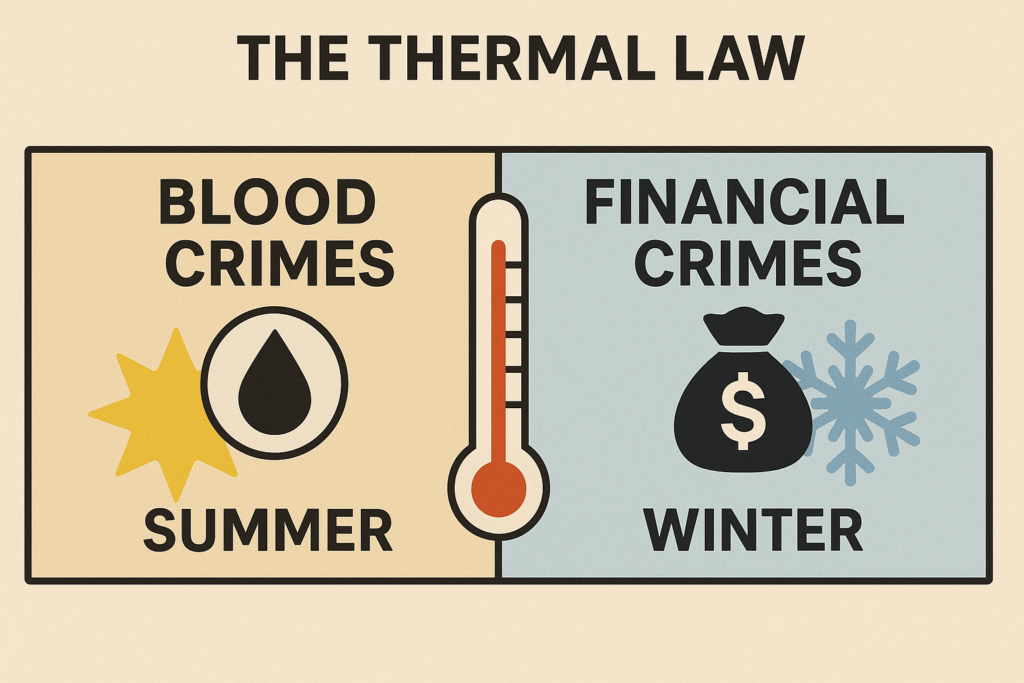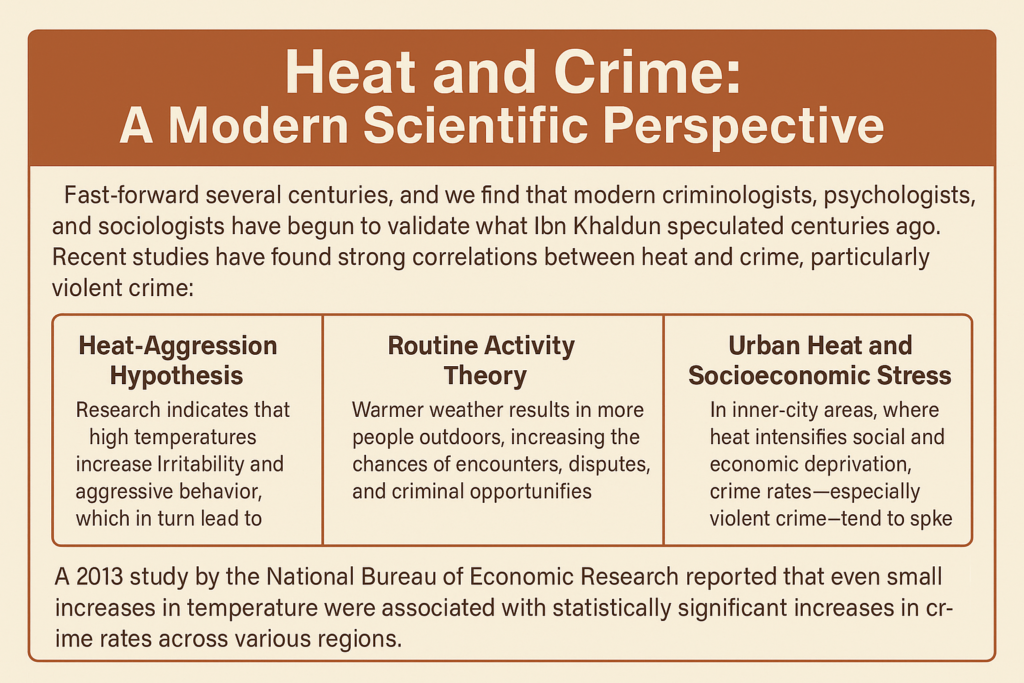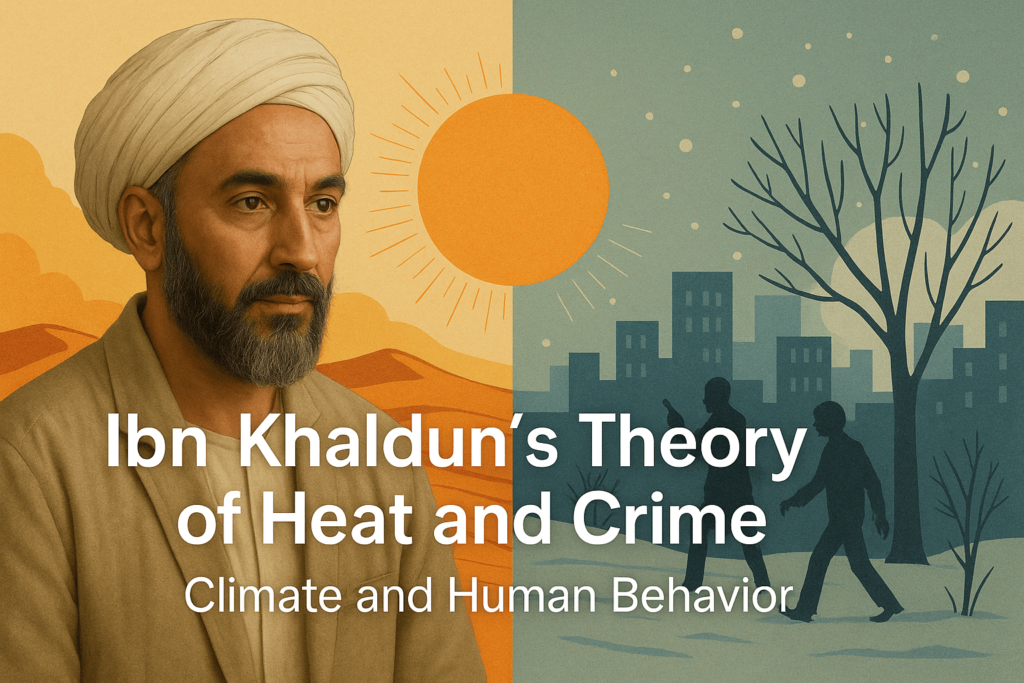Introduction
The link between climate and human behavior has intrigued scholars for centuries. One of the earliest thinkers to propose a connection between environmental factors and social dynamics was the 14th-century Arab scholar Ibn Khaldun. In his seminal work Muqaddimah, Ibn Khaldun suggested that heat and climate significantly influence individuals’ temperaments, social organization, and even criminal tendencies. His observations, though rooted in pre-modern science, remarkably predate contemporary studies that investigate the relationship between heat and crime. This article explores Ibn Khaldun’s theory in depth, connects it to modern criminological perspectives, and analyzes how his ideas can be re-evaluated in light of current discussions on climate and crime.
Who Was Ibn Khaldun?
Ibn Khaldun (1332–1406) was a North African Arab historiographer, philosopher, and sociologist who laid the foundations for various disciplines, including sociology, historiography, and economics. He is best known for his Muqaddimah (“Introduction”), in which he analyzed the rise and fall of civilizations and introduced innovative concepts related to culture, politics, and economics. Among his various insights, one particularly fascinating idea is his theory of how climatic conditions—particularly heat—affect human character, society, and crime.
The Thermal Law: Ibn Khaldun’s Legacy and the Seasonal Logic of Crime
The concept known today as the “Thermal Law” finds its earliest intellectual roots in the work of the 14th-century Arab thinker Ibn Khaldun, who can rightly be considered the originator of this theory. Long before the advent of modern criminology and psychology, Ibn Khaldun observed that climate—particularly heat—affects not only the temperament of individuals but also the nature and frequency of crimes within a society.
Ibn Khaldun proposed that in hot climates, people tend to become more emotionally reactive and impulsive. He believed that intense heat could lower self-restraint and increase the likelihood of violent reactions, especially in communities where social controls are weak or institutions are unstable. This idea later evolved into what scholars today call the Thermal Law: a pattern linking heat with violent crime (blood crimes) and cold with economic crime (financial offenses).
Summer and Blood Crimes
In regions and periods of intense heat—such as midsummer—there is a consistent rise in blood crimes: murders, assaults, domestic violence, and other forms of interpersonal aggression. The reasoning, both ancient and modern, is multifaceted:
- Biological stress from heat increases irritability and impulsivity.
- Increased outdoor interaction raises the chance of conflicts and confrontations.
- Reduced tolerance in the face of minor provocations escalates into violence.
Ibn Khaldun noted that such patterns were more evident in hot zones of the world, where both natural heat and social tension contributed to societal unrest and disorder.
Winter and Financial Crimes
In contrast, colder seasons and climates tend to suppress physical activity and emotional outbursts but give rise to calculated, opportunistic crimes. These include:
- Theft and burglary, often during holiday seasons when homes are left unattended.
- Fraud and cybercrime, due to increased online activity in colder months.
- Embezzlement and financial scams, motivated by economic hardship or personal gain.
According to the Thermal Law, these financial crimes are less about emotional explosion and more about rational exploitation, a shift that reflects the psychological influence of cold environments—introspective, restrained, but potentially more deceptive.
Ibn Khaldun’s Pioneering Contribution
While contemporary researchers may use advanced statistical models and data analytics to explore the heat and crime relationship, Ibn Khaldun deserves credit for laying the philosophical foundation of the Thermal Law. His insights were centuries ahead of his time, recognizing how environmental and climatic conditions shape not only culture and economy but also patterns of criminal behavior. He approached crime not as a purely legal or moral issue, but as a sociological phenomenon influenced by geography and weather—a remarkably modern viewpoint.
His observations imply that crime is not static, but fluctuates with environmental cycles, a principle that remains central to contemporary criminological research. Today, this concept is being revisited with urgency in light of global warming and the emerging connections between climate change and violence.

The Climate Theory in Ibn Khaldun’s Muqaddimah
Ibn Khaldun observed that people living in extremely hot climates, especially in the tropics or deserts, tended to develop distinct behavioral patterns compared to those in temperate regions. According to him:
- Excessive heat weakens physical and mental energy.
- Populations in hotter climates are more emotional and less rational.
- The abundance or scarcity of resources in hot regions impacts social cohesion and law enforcement.
- The heat and crime relationship is partly driven by psychological and economic stresses induced by the climate.
Although Ibn Khaldun’s analysis lacks the empirical methods used in modern science, his general premise—that environment plays a major role in shaping human conduct—was groundbreaking.
Linking Heat and Crime: Ibn Khaldun’s Early Observations
Ibn Khaldun didn’t speak of “crime” in the modern legalistic sense, but he made indirect references to behaviors we would today classify as criminal:
- Social disorder in hot climates due to weakened governance structures.
- Aggression and impulsivity more common among populations in extreme heat.
- Moral laxity and lack of discipline in communities where the environment makes survival easier, thus diminishing the need for structured labor or law.
These observations offer a proto-theory of the heat and crime correlation that has been examined in much more depth in contemporary criminology.
Heat and Crime: A Modern Scientific Perspective
Fast-forward several centuries, and we find that modern criminologists, psychologists, and sociologists have begun to validate what Ibn Khaldun speculated centuries ago. Recent studies have found strong correlations between heat and crime, particularly violent crime:
- Heat-Aggression Hypothesis: Research indicates that high temperatures increase irritability and aggressive behavior, which in turn lead to higher rates of assault, domestic violence, and even homicide.
- Routine Activity Theory: Warmer weather results in more people outdoors, increasing the chances of encounters, disputes, and criminal opportunities.
- Urban Heat and Socioeconomic Stress: In inner-city areas, where heat intensifies social and economic deprivation, crime rates—especially violent crime—tend to spike.
A 2013 study by the National Bureau of Economic Research reported that even small increases in temperature were associated with statistically significant increases in crime rates across various regions.

Reinterpreting Ibn Khaldun in a Modern Framework
Modern researchers might critique the deterministic undertones of Ibn Khaldun’s theory, yet his fundamental insight—that climate affects societal behavior—still resonates. Reinterpreted today, his ideas align with ecological criminology, which emphasizes that environmental conditions shape social behavior and law-breaking tendencies.
Moreover, his holistic approach—connecting economics, governance, psychology, and geography—echoes modern interdisciplinary studies on heat and crime. His work suggests that crime cannot be divorced from its broader climatic and social context.
Climate Change and the Future of Crime
With global warming intensifying heat waves and raising average temperatures across the globe, the relevance of Ibn Khaldun’s theory has only increased. The future may see rising crime trends in vulnerable regions due to:
- Increased aggression and mental stress in high-temperature zones.
- Strained resources and weakened institutions in impoverished hot areas.
- Climate migration triggering new forms of conflict and criminality.
Recent UN and Intergovernmental Panel on Climate Change (IPCC) reports have highlighted these risks, noting that rising heat may indirectly fuel crime through socio-economic instability and psychological strain.
Criticism and Limitations of Ibn Khaldun’s Theory
Despite its forward-thinking aspects, Ibn Khaldun’s theory is not without criticism:
- Lack of empirical evidence: His conclusions were based on observation and anecdote, not scientific method.
- Cultural generalizations: Some claims regarding certain ethnic groups and climates verge on cultural bias.
- Oversimplification: Not all hot regions experience high crime rates; socioeconomic and political factors are equally crucial.
Modern researchers caution against using environmental determinism to explain crime without considering structural inequalities, historical legacies, and governance quality.
Conclusion: Ibn Khaldun’s Enduring Relevance
Ibn Khaldun’s theory of heat and crime serves as an intellectual bridge between early philosophical reasoning and modern scientific inquiry. His reflections on how climate shapes human behavior remain relevant as we confront the challenges of climate change and its impact on public safety. By revisiting his work with a critical and informed perspective, scholars can deepen our understanding of the complex relationship between heat and crime, and draw valuable lessons for criminology, sociology, and environmental studies alike.


